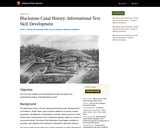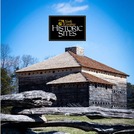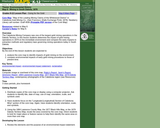
This parent guide supports parents in helping their child at home with the 8th grade Social Studies content.
- Subject:
- Social Studies
- Material Type:
- Reference Material
- Vocabulary
- Author:
- Kelly Rawlston
- Letoria Lewis
- Date Added:
- 10/12/2022

This parent guide supports parents in helping their child at home with the 8th grade Social Studies content.

This resource accompanies our Rethink 8th Grade Social Studies course. It includes ideas for use, ways to support exceptional children, ways to extend learning, digital resources and tools, tips for supporting English Language Learners and students with visual and hearing impairments. There are also ideas for offline learning.

This resource explains biomass and biofuels and how they are used as alternative forms of energy.

Birth of a Colony explores the history of North Carolina from the time of European exploration through the Tuscarora War. Presented in five acts, the video combines primary sources and expert commentary to bring this period of our history to life. The accompanying teacher guides provide lesson activity ideas, vocabulary, and additional reading resources to compliment each act's theme. The 5 act themes are: First on the Land, The Road to Zacatecas, The Roanoke Voyages, A New Voyage to North Carolina, and , The Tuscarora War.

In this lesson, students perform a close reading of an informational text to learn about the history of the Blackstone Canal.

If students take away anything from Remarkable Journey, it is hopefully the incredible ways the Indian community has contributed to the progress, growth, diversity and richness of the state of North Carolina. In this activity (best conducted after students have been exposed to multiple clips or the entire film,) students will consider all that they have learned about India and its people then create movie poster for Remarkable Journey that they think best highlights these themes.

This virtual field trip from Historic Bath State Site is a fun way to learn more about a kid's life in the 18th century. The field trip packet contains ,links to YouTube videos of costumed interpreters demonstrating historic activities, pre- and post-watch content for educators that provide context and engagement, and follow-up activities (games, crafts, and coloring pages). Live Q&A can be booked as part of the field trip as well.

In this lesson, students will familiarize themselves with some basic facts about India that highlight its diversity. Students will then view excerpts from (or the entirety of) Remarkable Journey and utilize the film’s information as a jumping off point to learn about various aspects of Indian culture (food, music, film, clothing, dance, and religion.) Yet, despite such diversity, Asian Indian immigrants to North Carolina, fellow strangers in a strange land, often rely on their shared roots to build new and unified communities. Students will discuss this concept then use their discoveries to create a mural that exemplifies the theme: "India: Unity in Diversity."

In this lesson, students will examine the impact of North Carolina's economic and technological advances on the environment, as well as North Carolina organizations and laws created to address such impact, by connecting these issues to those posed in Dr. Seuss's The Lorax. Though classified as a children's book, The Lorax contains mature themes regarding the increasing negative effects human action and irresponsibility is having on the environment. In this lesson students will read the story or watch the movie and hold a mock hearing of the North Carolina Environmental Management Commission about the damage the Onceâ€ler has done to the environment.

India is a diverse land of religions and spirituality. It is not only the birthplace of Hinduism, Buddhism, Jainism, and Sikhism, but numerous other faiths are practiced there, including Islam, Christianity, Judaism, Zoroastrianism, and others. Through viewing clips from Remarkable Journey and completing the following activities, students will explore the various religions with connections to India, as well as the way Asian Indians have integrated their diverse religions into communities across North Carolina. As a culminating activity, students will delve further into one particular religion mentioned during class by creating a scrapbook of that religion.

Fort Dobbs has created a series of short videos designed to teach students about the settlement of the Northwest Carolina backcountry, the lives of the Native Americans living in and near the region of Fort Dobbs, the life of a North Carolina Provincial Soldier, and North Carolina's role during the French and Indian War. The videos are designed for teachers to use them separately to fit into their own lessons or can be grouped together by theme.

This resource explains geothermal energy and how it is used as an alternative form of energy.

Students determine the impact of gold mining operations in 1879 on the immediate environment and compare the early impacts to extraction methods and regulatory laws governing mining operations today in South Dakota.

This resource explains hydropower and how it is used as an alternative form of energy.

In this lesson, students will consider immigration in general as well as through the specific lens of the Asian Indian immigrant experience by viewing clips from Remarkable Journey. Students will explore their own immigrant ancestry as they consider the concept of America as a "Nation of Immigrants," as well as the varying reasons for immigration throughout history, the varied experiences of immigrants, their relationship to the American Dream, and the misconceptions that often frame immigration in our society. As a culminating artistic activity, students will create an updated Statue of Liberty - a new design that addresses immigration, America as a "Nation of Immigrants," the concept of the "American Dream," and the related concepts addressed throughout the lesson.

In this lesson students read diary entries and analyze works of art to develop generalizations about the influence of physical features on westward settlement patterns in the mid-1800s.

In this lesson, students are drawn into post-Revolutionary Philadelphia during the midst of the infamous yellow fever epidemic of 1793 by reading Laurie Halse Anderson's novel Fever 1793. Use this novel as supplemental reading to assist students in developing their understanding of and interest in colonial times, while heightening their reading skills and ability for higher order thinking.

With this lesson, students analyze the connection between history and identity, explore what is gained and what is lost learning a new culture, and develop a working definition of the word refugee. The lesson is located on pages 8-11 of the pdf.

In this lesson, students explore the different regions of North Carolina and how the topography of the region affected economic, social, and political development by completing one of the projects options included.

Students will learn about America's first gold rush, which took place in North Carolina in the early 1800s. They will then utilize their understanding of the gold rush and its affect on North Carolina by completing a creative writing assignment.